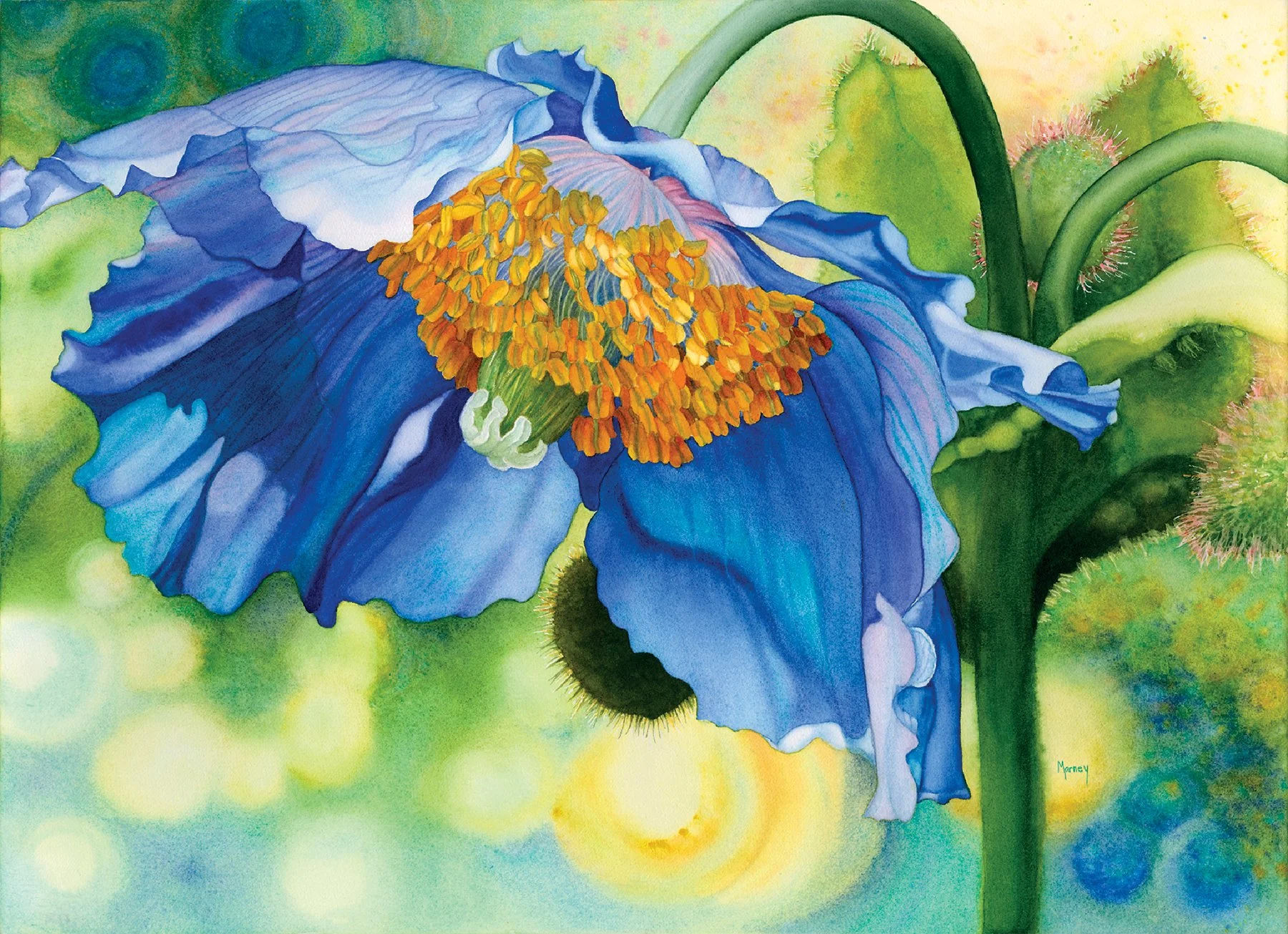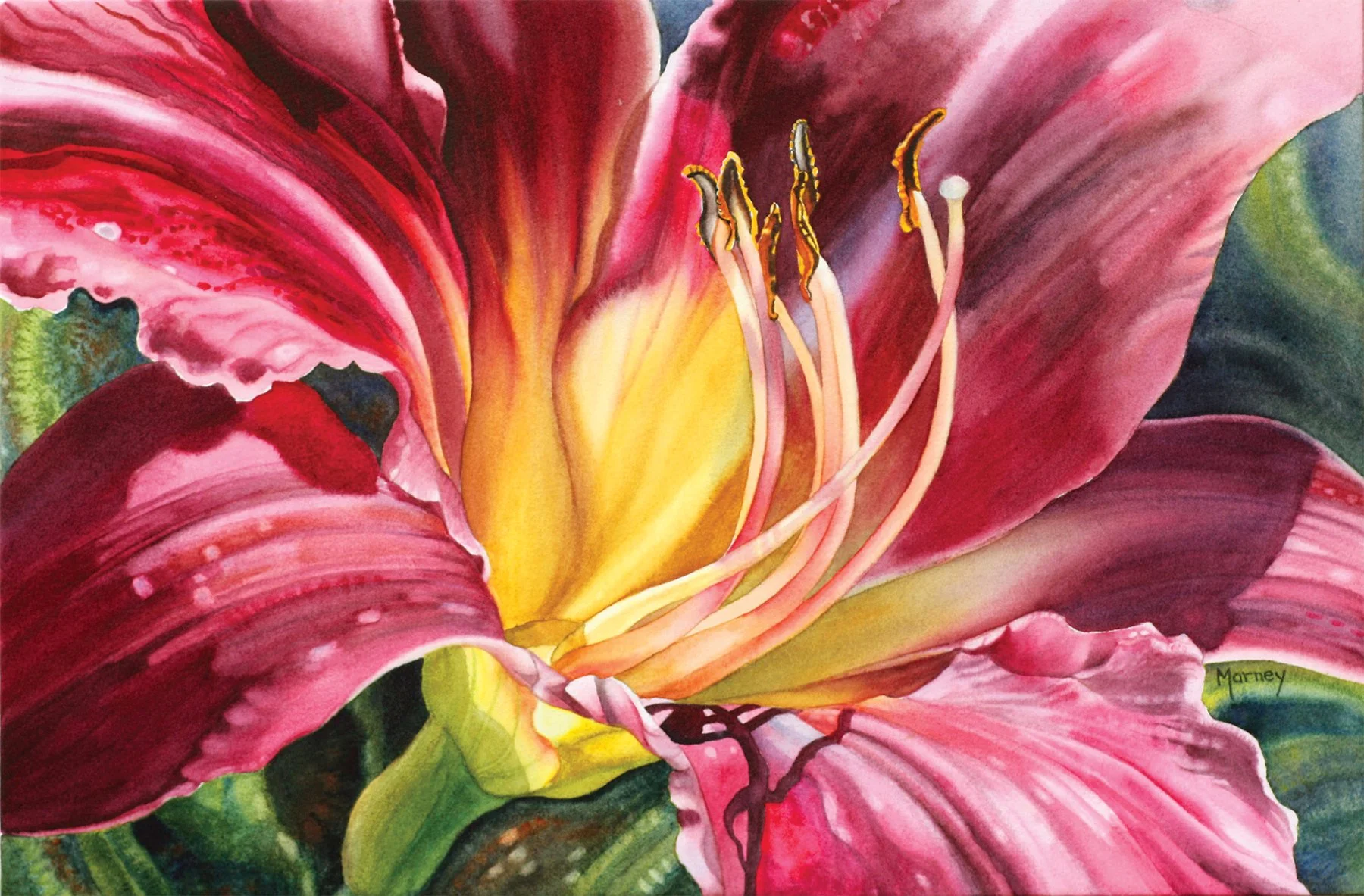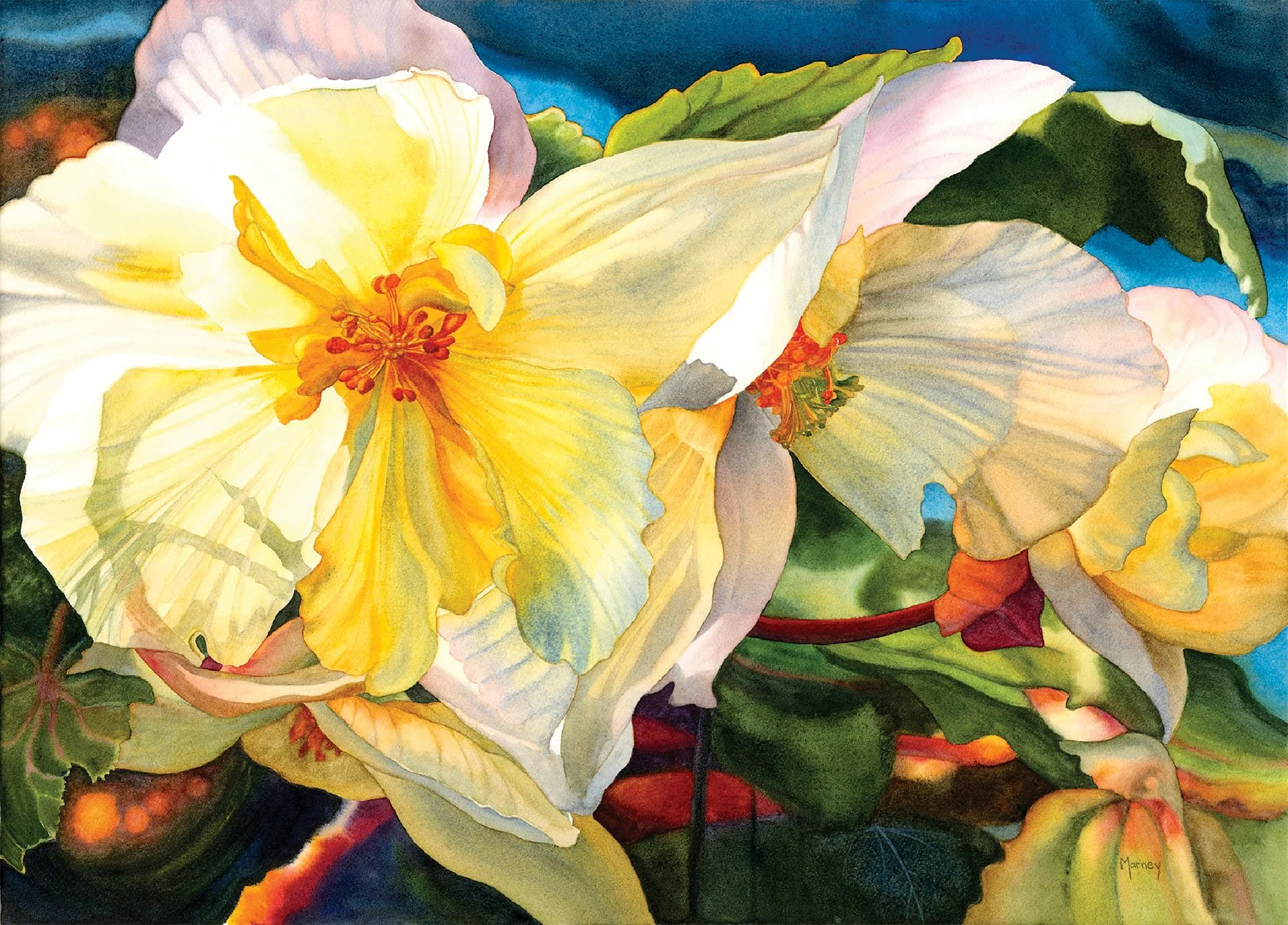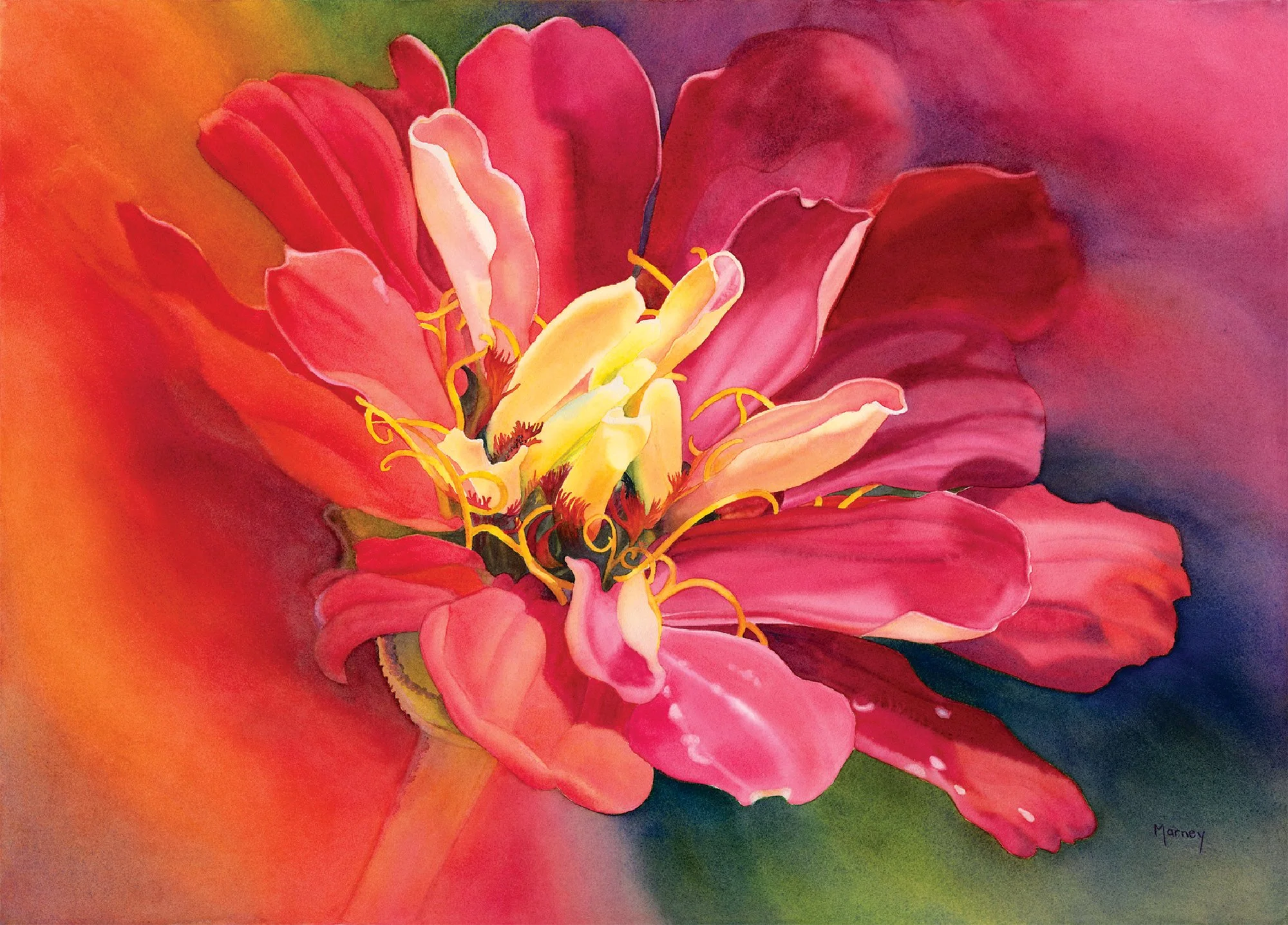Marney Ward, A Burst of Blue
Marney Ward, Burgundy Lily
Marney Ward, Butchart's Begonias
Marney Ward, Light Filled Peony II
Marney Ward, Pink Dahlia
Marney Ward, Zinnia
Marney Ward
Marney Ward’s paintings go beyond botanical precision, capturing the quiet emotional and spiritual presence she finds in every flower.
Marney Ward has always loved flowers. “My mother had an enormous garden with flower borders and rockeries, and I learned about each flower from her,” she says. “And flowers come in such a wonderful range of colors, from delicate to shocking, many with transparent petals that filter light in marvelous ways.”
Inspired by the gardens near her home in Victoria, British Columbia, Canada, Ward has developed her own distinctive style, creating back-lit paintings of detailed, light-filled flowers. But the unusual quality in Ward’s work is her ability to reveal an emotional and spiritual connection to each flower, with results that transcend mere botany to become portraits in the truest sense of the word, capturing the likeness, personality, and emotions of her floral subjects.
We spoke to Ward recently about how she captures the “soul of flowers.”
How do you balance making an accurate depiction of a flower with evoking emotion from the viewer?
I think each flower creates its own emotion, or at least my response to each flower does. So, the more accurate the rendition, the more powerful the emotion associated with it. However, I do get to choose how I present the flower, what kind of background to give it, whether to paint just one flower or several and whether to include buds and leaves, so there are lots of choices I can make to help create the feeling I want.
How do you choose your colors?
The colors I paint come from the flower, but I modify them when I want to. For example, I can make them more muted or more intense, cooler or warmer, or I can leave out some colors altogether. For the backgrounds, I really listen to my heart and design a background that complements the flowers, usually cooler and more muted than the color of the flower.
You’ve spoken about flowers as having distinct personalities — some shy, some exuberant, some almost meditative. How do you attune yourself to that individual essence?
The personality of the flower will help me decide how I want to present it. A dramatic flower requires a more dramatic composition and stronger, more contrasting colors. I treat delicate flowers with more delicate colors, less contrasts in value, and perhaps a somewhat expanded background, as delicate flowers are more willing to share the stage.
Why have you chosen watercolor as your medium?
I’ve always loved watercolor and feel its transparency and delicacy are perfect for florals. In particular, I love the way the light in watercolors comes from the underlying paper, it’s not added on with opaque white paint the way it is in other mediums.
How do you retain luminosity in your work?
In watercolor, luminosity comes from the white of the paper, it’s like the soul shining through the individual body of the painting. The artist creates the body but has to constantly understand that the soul needs to be respected, nourished, and sculpted into each individual painting. If it’s covered up with too much paint, the painting won’t glow, it won’t resonate with life. I keep the parts of the paper I want to remain white or very light, unpainted until the end. Then I might wet that area and add pale washes of paint to some or all of it, or I’ll leave some or all of it dry to provide the brightest, purist white.
Can you control the textures created by using salt and granulating pigments, or is not controlling them an important aspect of your work?
I think when I add salt or use granulating pigments to add texture to a painting, it’s a balance of control and surrender. Experience has taught me what to expect, unless I’m trying something completely different, but I also understand that to some extent, all bets are off. So, I’m delighted when something new and extraordinary happens.
Your compositions often show a single flower or closeups of a flower. How do you decide on a composition for a piece?
My compositions depend on the personality of the flower and the mood I’m in at the time; what kind of painting am I feeling like creating.
A zinnia is a very “in your face” kind of flower, so in my painting “Zinnia” I painted a red one in a very bold, dramatic way, with the flower taking up most of the paper. I consider flowers like daisies and daffodils “friendly flowers” as they usually grow in clumps, so I generally portray them in multiples.
I love light and take most of my flower photos backlit with the light streaming through the petals, but this effect requires fairly delicate, translucent petals, like those in peonies or poppies. Flowers with heavier, thicker, or more velvety petals, like zinnias or magnolias, I paint differently, but I’ll still find a way to introduce light into the painting.
How do you decide on a background for a painting?
I almost never use the background from the photo; I create my own. I think backgrounds need to support the main event, the flower, so they are usually duller and darker, as my flowers are generally lighter colored.
In more recent paintings, I often use bubbles of light to add a feeling of lightness and airiness to the painting, but also to guide the eye into and around the painting. Before I started using bubbles, I often used lines of salt to create a similar movement around the painting, or just lines of darker or lighter paint, using water and/or paint. These “energy lines” add life and movement to the painting as a whole. The bubbles also add an ethereal quality to the painting, and a happy, bouncy kind of movement.
—————-
Ward has signature status from both the Federation of Canadian Artists (SFCA) and the Society of Canadian Artists (SCA). Her work has garnered more than 20 awards, been exhibited widely, featured in numerous professional art magazines and books; and she has developed an eight-week online course teaching floral watercolors.
All images © Marney Ward, shared with permission.







